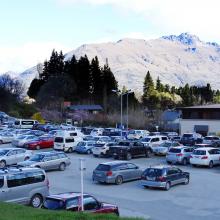
The Queenstown Lakes District Council knows it is damned if it does and damned if it does not on inner-town parking.
Queenstown topography has created a landscape where growth issues are magnified. It is not just extremely difficult to find enough suitable land for houses but also for cars.
The roads become crammed and parking spaces run out.
While Queenstown and the Wakatipu might only have a permanent population of about 17,000, visitors swell that to 100,000 or beyond at any one time. As the manager of Queenstown’s CDB has said, the community needs big city plans to sort the matter out.
One of these is the adoption of the Queenstown Town Centre Transport Strategy, agreed to by councillors on Thursday. This is causing much "angst" among residents, as councillors acknowledge. They describe it as just one step in improving the liveability and visitor experience of the town.
Its stark feature is removing more free parks around the wider CBD and increases in parking fees. From February, motorists who work in town will pay $40 a day to park in a council-owned car park.
Quite clearly, this will be impossible for most workers. Coming on top of sky-high rents or likely mortgage repayments, commuting by car will no longer be an option for many.
The council is pushing ahead with these changes, arguing current congestion trends cannot continue. Twenty years ago Queenstown drew residents from the likes of Auckland because it was relatively quiet and easy to get around. Not so anymore. Traffic jams at peak times have become commonplace and the roads cannot cope.
The changes are also taking place at the same time as improved bus services are introduced, including flat $2 fares.
Many workers in town will have to switch to buses whether they like it or not. At the same time bus services will have to extend widely across the Wakatipu, and at all sort of hours.
What about, for example, hospitality staff who finish work at 4am at the weekend?
On incomes likely to be not much above the minimum wage, how are they to get to and from their jobs?
And can a town as small as Queenstown sustain extensive public transport?
It will never be like big cities with thousands commuting to and from their skyscraper desks.
Life for workers with children will also change.
Without cars, they will lose the flexibility of care during the day. Workers far from bus routes will struggle.
Costs will increase for businesses whose staff rely on vehicles during the day. Where possible, more will shift out of the CBD. Sensibly, the high school is leaving the area. Two primary schools remain.
Already, a parking building is planned for gondola staff and visitors.
More will be needed, and a park-and-ride scheme might need to be introduced. Lake commuter ferries might also relieve a little pressure on the roads.
The council is making a tough call. It is saying the combination of heavily subsidised buses and free or cheap parking cannot work.
This change requires a fundamental change in mindset for workers and residents, and it will be difficult.
Queenstown is losing an essential element of its small town feel and lifestyle, and that forced change in attitudes will be far from popular.
For now, buses are to seen as a means to ameliorate roading and parking pressure. As Queenstown’s supercharged growth continues, further change will be necessary in the decades ahead and non-roading transportation (aerial rail, gondolas?) could well enter the picture.












